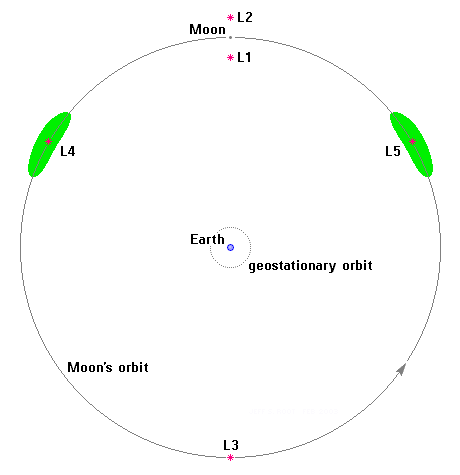

Lagrange points are locations in space where gravitational forces and the orbital motion of a body balance each other. They were discovered by French mathematician Louis Lagrange in 1772 in his gravitational studies of the 3-body problem: how a third, small body would orbit around two orbiting large ones.
His solution was astronomically confirmed in 1906 with the discovery of the Trojan asteroids orbiting at the Sun-Jupiter L-4 and L-5 points. More recently the Voyager probes found tiny moonlets at the Saturn-Dione L-4 point and at the Saturn-Tethys L-4 and L-5 points.
An object at L1, L2, or L3 is meta-stable, like a ball sitting on top of a hill. A little push or bump and it starts moving away. A spacecraft at one of these points has to use frequent, small rocket firings or other means to remain in the area. Orbits around these points are called 'halo orbits'. The Solar and Heliospheric Observatory (SOHO) is in a halo orbit around the Sun-Earth L1 position, about a million miles Sunward from Earth, and the Microwave Anisotropy Probe (MAP), is in a halo orbit around the Sun-Earth L2 Position, about a million miles in the opposite direction. These are the first spacecraft to be positioned in Lagrange orbits.
An object at L4 or L5 is truly stable, like a ball in a bowl: when gently pushed away, it orbits the Lagrange point without drifting farther and farther, and without the need of frequent rocket firings. The Sun's pull makes any object in the Earth-Moon L4 and L5 locations "orbit" the Lagrange point in an 89-day cycle. These regions could be ideal for the Space habitats devised by Gerard K. O'Neill in 1969. Each habitat could house tens of thousands of people. One project that people living in Space habitats might work on would be to build solar power satellites, invented by Peter Glaser in 1968, which could provide electric power not only for the habitats but for the Earth as well. Space habitats might also be excellent bases for interplanetary exploration.
Solar power satellites (powersats) manufactured at Space habitats would be moved down to geostationary orbit to supply power to Earth. Geostationary orbit, marked out in a dotted circle in the above map, is that particular orbit where it takes exactly 24 hours to orbit the Earth. Since the Earth also rotates in 24 hours the satellite will appear stationary in the sky when viewed from the ground. Many communications satellites (comsats) can be found here. This orbit is also called geosynchronous orbit or Clarke's orbit, for the science fiction author who realized its utility for comsats in 1945.
(You might want to visit another Lagrange Points page at NASA.)
rab, jsr & dlb